英语八大时态
英语八大时态

八大时态一、一般现在时:1.概念:经常、反复发生的动作或行为及现在的某种状况。
2.时间状语: always, usually, often, sometimes, every week (day, year, month…), once a week, on Sundays,3.基本结构:动词原形(如主语为第三人称单数,动词上要加(e)S)4.否定形式:am/is/are+not;此时态的谓语动词若;为行为动词,则在其前加don't,如主语为第三人称单数,则用doesn't,同时还原行为动词。
4.一般疑问句:把be动词放于句首;用助动词do提问,如主语为第三人称单数,则用does,同时,还原行为动词。
5.例句:. It seldom snows here.He is always ready to help others.Action speaks louder than words.二、一般过去时:1.概念:过去某个时间里发生的动作或状态;过去习惯性、经常性的动作2.时间状语:ago, yesterday, the day before yesterday, last week(year, night, month…), in 1989, just now, at the age of 5, one day, long long ago, once upon a time, etc.3.基本结构:be动词;行为动词4.否定形式:was/were+not;在行为动词前加didn't,同时还原行为动词。
5.一般疑问句:was或were放于句首;用助动词do的过去式did 提问,同时还原行为动词。
6.例句:She often came to help us in those days.I didn't know you were so busy.三、现在进行时:1.概念:表示现阶段或说话时正在进行的动作及行为。
英语八大时态结构_含例句
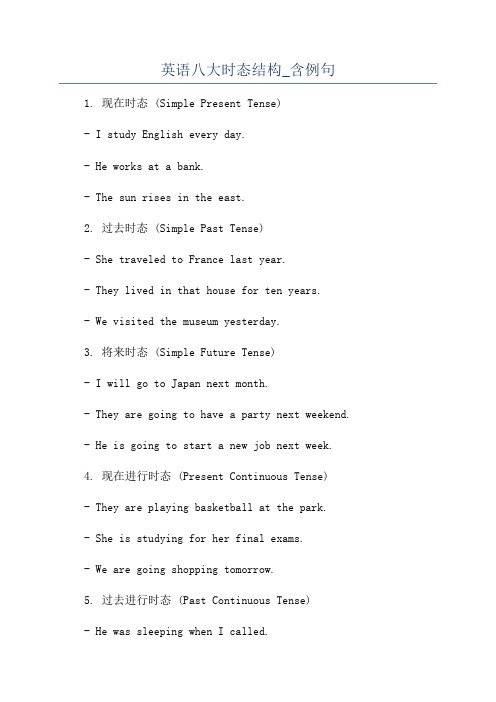
英语八大时态结构_含例句1. 现在时态 (Simple Present Tense)- I study English every day.- He works at a bank.- The sun rises in the east.2. 过去时态 (Simple Past Tense)- She traveled to France last year.- They lived in that house for ten years.- We visited the museum yesterday.3. 将来时态 (Simple Future Tense)- I will go to Japan next month.- They are going to have a party next weekend. - He is going to start a new job next week. 4. 现在进行时态 (Present Continuous Tense)- They are playing basketball at the park.- She is studying for her final exams.- We are going shopping tomorrow.5. 过去进行时态 (Past Continuous Tense)- He was sleeping when I called.- They were studying at the library all day.- We were driving to work when it started raining.6. 将来进行时态 (Future Continuous Tense)- She will be taking a vacation next month.- They will be working on a project all night.- We will be having dinner at a nice restaurant tomorrow.7. 现在完成时态 (Present Perfect Tense)- I have finished my homework.- He has seen that movie before.- They have already visited that museum.8. 过去完成时态 (Past Perfect Tense)- She had already left when we arrived.- They had finished their meal before we came.- He had already bought the tickets when I called.。
英语八大时态
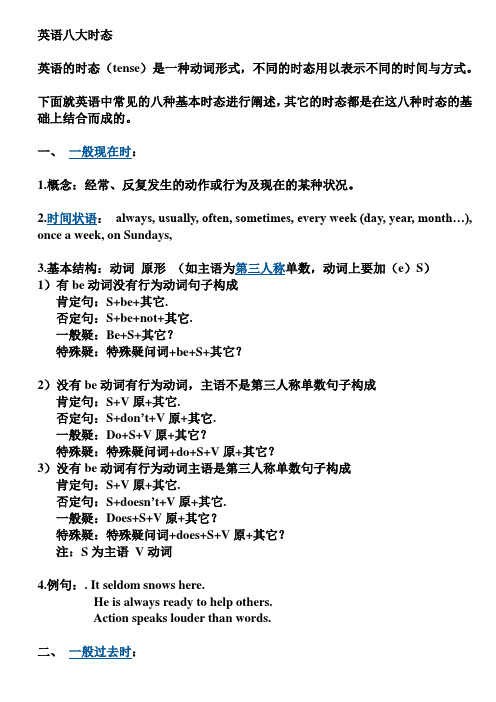
英语八大时态英语的时态(tense)是一种动词形式,不同的时态用以表示不同的时间与方式。
下面就英语中常见的八种基本时态进行阐述,其它的时态都是在这八种时态的基础上结合而成的。
一、一般现在时:1.概念:经常、反复发生的动作或行为及现在的某种状况。
2.时间状语:always, usually, often, sometimes, every week (day, year, month…), once a week, on Sundays,3.基本结构:动词原形(如主语为第三人称单数,动词上要加(e)S)1)有be动词没有行为动词句子构成肯定句:S+be+其它.否定句:S+be+not+其它.一般疑:Be+S+其它?特殊疑:特殊疑问词+be+S+其它?2)没有be动词有行为动词,主语不是第三人称单数句子构成肯定句:S+V原+其它.否定句:S+don’t+V原+其它.一般疑:Do+S+V原+其它?特殊疑:特殊疑问词+do+S+V原+其它?3)没有be动词有行为动词主语是第三人称单数句子构成肯定句:S+V原+其它.否定句:S+doesn’t+V原+其它.一般疑:Does+S+V原+其它?特殊疑:特殊疑问词+does+S+V原+其它?注:S为主语V动词4.例句:. It seldom snows here.He is always ready to help others.Action speaks louder than words.1.概念:过去某个时间里发生的动作或状态;过去习惯性、经常性的动作、行为。
2.时间状语:ago, yesterday, the day before yesterday, last week(year, night, month…), in 1989, just now, at the age of 5, one day, long long ago, once upon a time, etc.3.基本结构:be动词;行为动词1)有be动词没有行为动词句子构成肯定句:S+was/were+其它.否定句:S+was/were+not+其它.一般疑:Was/Were+S+其它?特殊疑:特殊疑问词+ was/were +S+其它?2) 没有be动词有行为动词句子构成肯定句:S+Ved+其它.否定句:S+didn’t+V原+其它.一般疑:Did+S+V原+其它?特殊疑:特殊疑问词+did+S+V原+其它?6.例句:She often came to help us in those days.I didn't know you were so busy.三、现在进行时:1.概念:表示现阶段或说话时正在进行的动作及行为。
8个初中英语时态

8个初中英语时态8个初中英语时态是学习英语语法的重要组成部分,以下是它们的定义和例句:1. 现在一般时态:表示现在的动作或状态。
例如:I eat an apple every day. (我每天吃一个苹果。
)2. 过去一般时态:表示过去的动作或状态。
例如:She studied English last year. (她去年学了英语。
)3. 现在进行时态:表示正在进行的动作或状态。
例如:He is watching TV now. (他正在看电视。
)4. 过去进行时态:表示过去某个时间正在进行的动作或状态。
例如:They were having dinner when I called. (我打电话的时候他们正在吃饭。
)5. 现在完成时态:表示已经完成的动作或状态,强调对现在的影响。
例如:I have learned English for three years. (我已经学了三年英语了。
)6. 过去完成时态:表示过去某个时间之前已经完成的动作或状态。
例如:They had finished their homework by the time I arrived. (我到的时候他们已经完成作业了。
)7. 现在完成进行时态:表示从过去开始一直持续到现在的动作或状态,强调对现在的影响。
例如:He has been studying English for five years. (他已经学了五年英语了。
)8. 过去完成进行时态:表示从过去某个时间开始一直持续到过去的动作或状态。
例如:They had been waiting for the bus for an hour when I arrived. (我到的时候他们已经等了一个小时的车了。
)。
英语的8大时态
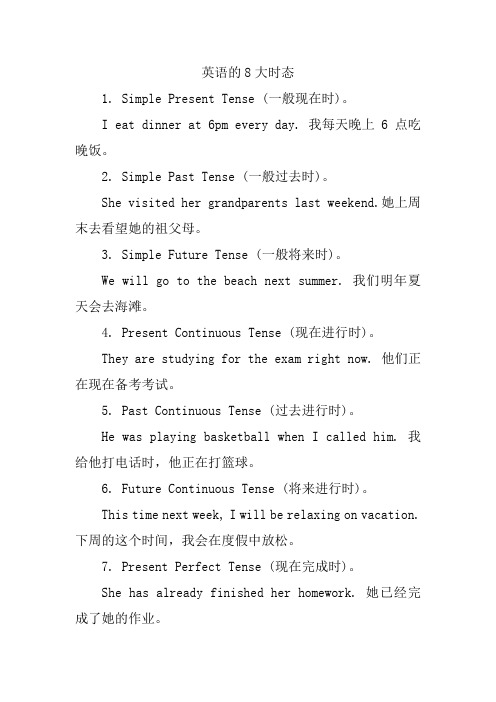
英语的8大时态1. Simple Present Tense (一般现在时)。
I eat dinner at 6pm every day. 我每天晚上6点吃晚饭。
2. Simple Past Tense (一般过去时)。
She visited her grandparents last weekend.她上周末去看望她的祖父母。
3. Simple Future Tense (一般将来时)。
We will go to the beach next summer. 我们明年夏天会去海滩。
4. Present Continuous Tense (现在进行时)。
They are studying for the exam right now. 他们正在现在备考考试。
5. Past Continuous Tense (过去进行时)。
He was playing basketball when I called him. 我给他打电话时,他正在打篮球。
6. Future Continuous Tense (将来进行时)。
This time next week, I will be relaxing on vacation. 下周的这个时间,我会在度假中放松。
7. Present Perfect Tense (现在完成时)。
She has already finished her homework. 她已经完成了她的作业。
8. Past Perfect Tense (过去完成时)。
By the time I arrived, they had already left. 我到达时,他们已经离开了。
这些是英语中常见的8种时态,希望对你有帮助。
英语里的八大时态
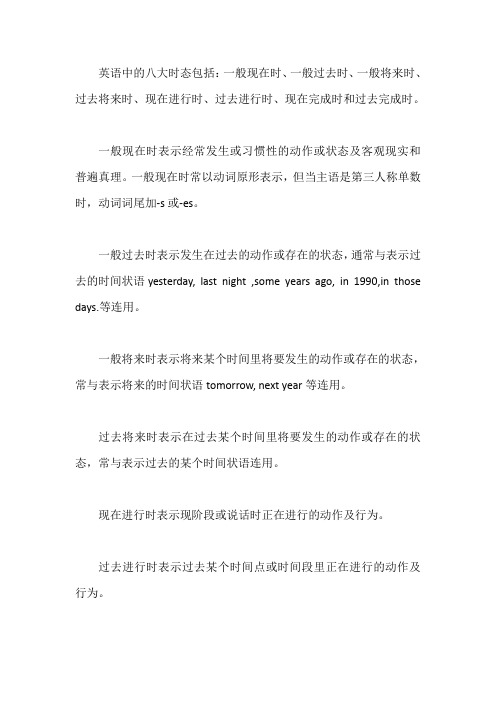
英语中的八大时态包括:一般现在时、一般过去时、一般将来时、过去将来时、现在进行时、过去进行时、现在完成时和过去完成时。
一般现在时表示经常发生或习惯性的动作或状态及客观现实和普遍真理。
一般现在时常以动词原形表示,但当主语是第三人称单数时,动词词尾加-s或-es。
一般过去时表示发生在过去的动作或存在的状态,通常与表示过去的时间状语yesterday, last night ,some years ago, in 1990,in those days.等连用。
一般将来时表示将来某个时间里将要发生的动作或存在的状态,常与表示将来的时间状语tomorrow, next year等连用。
过去将来时表示在过去某个时间里将要发生的动作或存在的状态,常与表示过去的某个时间状语连用。
现在进行时表示现阶段或说话时正在进行的动作及行为。
过去进行时表示过去某个时间点或时间段里正在进行的动作及行为。
现在完成时表示过去发生的动作对现在的影响,或者过去的动作一直持续到现在。
过去完成时表示过去的某个时间点之前已经完成的动作或存在的状态。
英语语法的八大时态
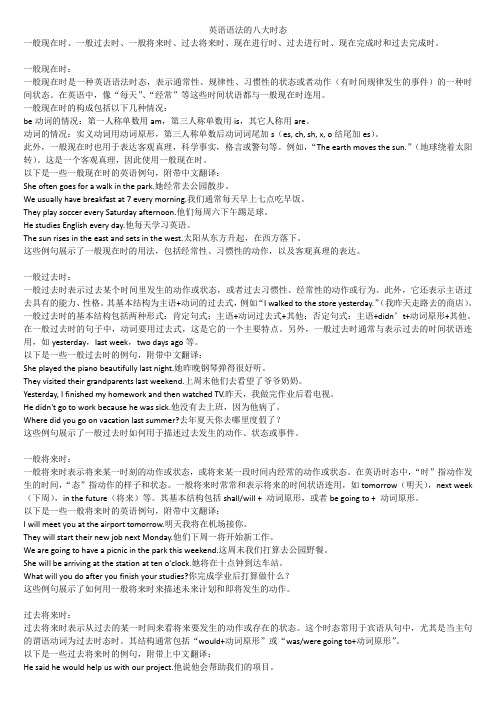
英语语法的八大时态一般现在时、一般过去时、一般将来时、过去将来时、现在进行时、过去进行时、现在完成时和过去完成时。
一般现在时:一般现在时是一种英语语法时态,表示通常性、规律性、习惯性的状态或者动作(有时间规律发生的事件)的一种时间状态。
在英语中,像“每天”、“经常”等这些时间状语都与一般现在时连用。
一般现在时的构成包括以下几种情况:be动词的情况:第一人称单数用am,第三人称单数用is,其它人称用are。
动词的情况:实义动词用动词原形,第三人称单数后动词词尾加s(es, ch, sh, x, o结尾加es)。
此外,一般现在时也用于表达客观真理,科学事实,格言或警句等。
例如,“The earth moves the sun.”(地球绕着太阳转)。
这是一个客观真理,因此使用一般现在时。
以下是一些一般现在时的英语例句,附带中文翻译:She often goes for a walk in the park.她经常去公园散步。
We usually have breakfast at 7 every morning.我们通常每天早上七点吃早饭。
They play soccer every Saturday afternoon.他们每周六下午踢足球。
He studies English every day.他每天学习英语。
The sun rises in the east and sets in the west.太阳从东方升起,在西方落下。
这些例句展示了一般现在时的用法,包括经常性、习惯性的动作,以及客观真理的表达。
一般过去时:一般过去时表示过去某个时间里发生的动作或状态,或者过去习惯性、经常性的动作或行为。
此外,它还表示主语过去具有的能力、性格。
其基本结构为主语+动词的过去式,例如“I walked to the store yesterday.”(我昨天走路去的商店)。
一般过去时的基本结构包括两种形式:肯定句式:主语+动词过去式+其他;否定句式:主语+didn’t+动词原形+其他。
英语八大时态总结
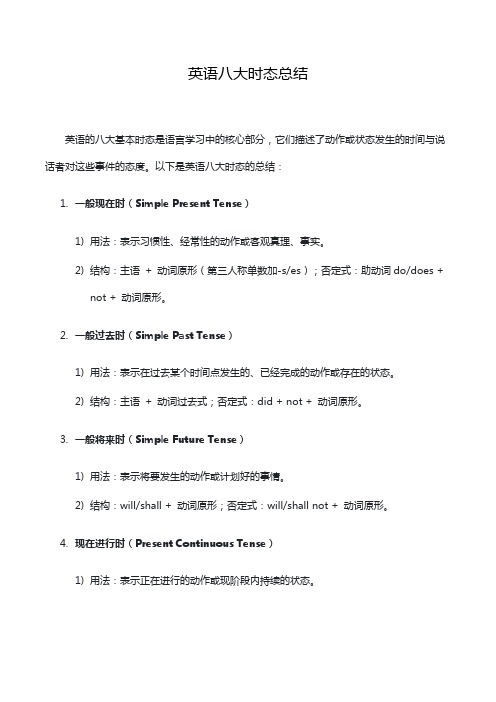
英语八大时态总结英语的八大基本时态是语言学习中的核心部分,它们描述了动作或状态发生的时间与说话者对这些事件的态度。
以下是英语八大时态的总结:1.一般现在时(Simple Present Tense)1)用法:表示习惯性、经常性的动作或客观真理、事实。
2)结构:主语+ 动词原形(第三人称单数加-s/es);否定式:助动词do/does +not + 动词原形。
2.一般过去时(Simple Past Tense)1)用法:表示在过去某个时间点发生的、已经完成的动作或存在的状态。
2)结构:主语+ 动词过去式;否定式:did + not + 动词原形。
3.一般将来时(Simple Future Tense)1)用法:表示将要发生的动作或计划好的事情。
2)结构:will/shall + 动词原形;否定式:will/shall not + 动词原形。
4.现在进行时(Present Continuous Tense)1)用法:表示正在进行的动作或现阶段内持续的状态。
2)结构:am/is/are + 动词-ing形式;否定式:am/is/are + not + 动词-ing形式。
5.过去进行时(Past Continuous Tense)1)用法:表示过去某段时间内正在进行的动作或背景。
2)结构:was/were + 动词-ing形式;否定式:was/were + not + 动词-ing形式。
6.现在完成时(Present Perfect Tense)1)用法:表示过去发生的动作对现在的影响或从过去一直持续到现在的情况。
2)结构:have/has + 过去分词;否定式:have/has + not + 过去分词。
7.过去完成时(Past Perfect Tense)1)用法:表示在过去的某一时间之前已经完成的动作。
2)结构:had + 过去分词;否定式:had + not + 过去分词。
8.将来完成时(Future Perfect Tense)1)用法:表示在将来某一时刻之前将要完成的动作。
初中英语语法八大时态总结
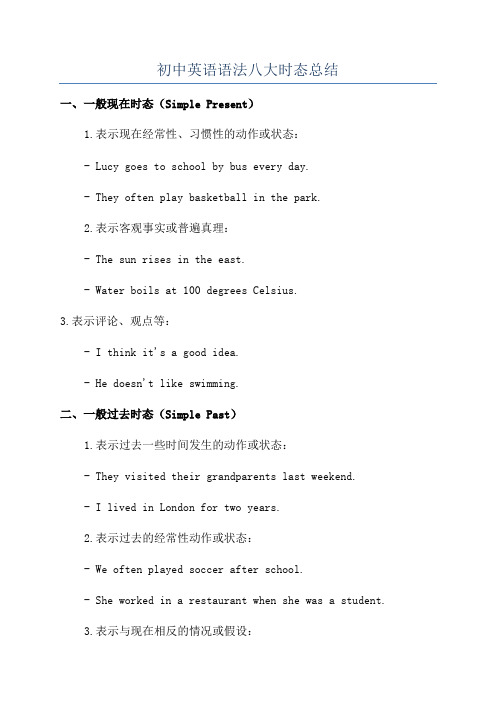
初中英语语法八大时态总结一、一般现在时态(Simple Present)1.表示现在经常性、习惯性的动作或状态:- Lucy goes to school by bus every day.- They often play basketball in the park.2.表示客观事实或普遍真理:- The sun rises in the east.- Water boils at 100 degrees Celsius.3.表示评论、观点等:- I think it's a good idea.- He doesn't like swimming.二、一般过去时态(Simple Past)1.表示过去一些时间发生的动作或状态:- They visited their grandparents last weekend.- I lived in London for two years.2.表示过去的经常性动作或状态:- We often played soccer after school.- She worked in a restaurant when she was a student.3.表示与现在相反的情况或假设:- If I had money, I would buy a new car.- I wish I could go to the concert with you.三、一般将来时态(Simple Future)1.表示将来要发生的事情:- I will meet him at the airport tomorrow.- They are going to have a party next week.2.表示意愿、打算或承诺:- I promise I will help you.- She is going to study abroad next year.四、现在进行时态(Present Continuous)1.表示现在正在进行或暂时的动作:- They are playing football in the park.- He is studying for the exam.2.表示现阶段的变化或趋势:- The population of the city is increasing rapidly.- More and more people are using smartphones.五、过去进行时态(Past Continuous)1.表示过去一些时间正在进行中的动作:- I was watching TV when she called me.- They were having dinner when the power went out.2.表示过去一些时间同时发生的两个动作:- While he was reading, his sister was playing the piano.- When I arrived, they were still waiting for you.六、将来进行时态(Future Continuous)1.表示将来一些时间正在进行的动作:- He will be sleeping when you arrive.2.表示将来一些时间同时发生的两个动作:- While you are washing the dishes, I will be cleaning the bathroom.- When I call you, she will be cooking dinner.七、现在完成时态(Present Perfect)1.表示过去发生但对现在有影响的动作或状态:- I have lost my key, so I can't open the door.- She has finished her homework, so she can watch TV now.2.表示经历或遭遇过的事情:- Have you ever been to Paris?- He has never seen such a beautiful sunset.八、过去完成时态(Past Perfect)1.表示在过去一些时间之前已经发生的动作或状态:- When I arrived, they had already left.2.表示过去一些时间之前一直存在或保持的状态:- He had lived in that house for 10 years before he moved out.- She had been planning the party for weeks.。
初中英语八大时态总结
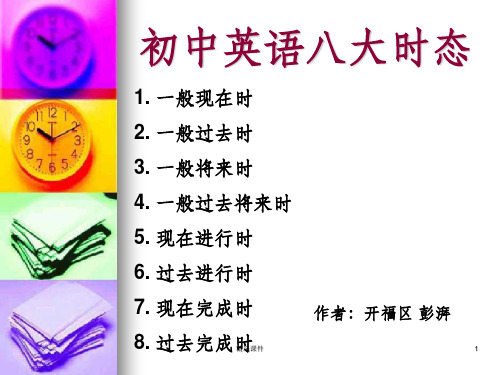
3. 一般将来时
will 加原型。
4. 一般过去将来时 would 加原型。
5. 现在进行时 6. 过去进行时 7. 现在完成时 8. 过去完成时精选课件
am/ is/ are +ing。 was/ were +ing。 have/ has + ed。 had + ed。
10
一般现在时 一般现在时,在没有be动词和助动词have,has,
一般现在时
精选课件
19
我昨天踢足球了。
一般过去时
精选课件
20
两星期前我说 过我将踢足球。
一般过去将来时
精选课件
21
我现在正 在踢足球。
现在进行时
精选课件
22
昨天的这个时候 我正在踢足球。
过去进行时
精选课件23Fra bibliotek我已经踢完足球了。
现在完成时
精选课件
24
昨天,你见到我 的时候,我早就 踢完足球了。
精选课件
8
过去完成时
含义:有两个过去时,其中一 个过去时比另一个过去时还要 过去,即一个动作发生在“过 去的过去”。 例如:昨天下午 我走进教室的时候同学们早就 坐好了、昨天当我走进电影院 的时候电影早就开始了。·
精选课件
9
初中英语八大时态
1. 一般现在时 2. 一般过去时
三单s,es其它无变化。 词尾加ed。
否: I did’t work here.
问:Did you work here?
答:Yes, I did./ No, I didn’t.
精选课件
12
一般将来时
肯: I wil work here.
英语语法八大时态总结(完整版)
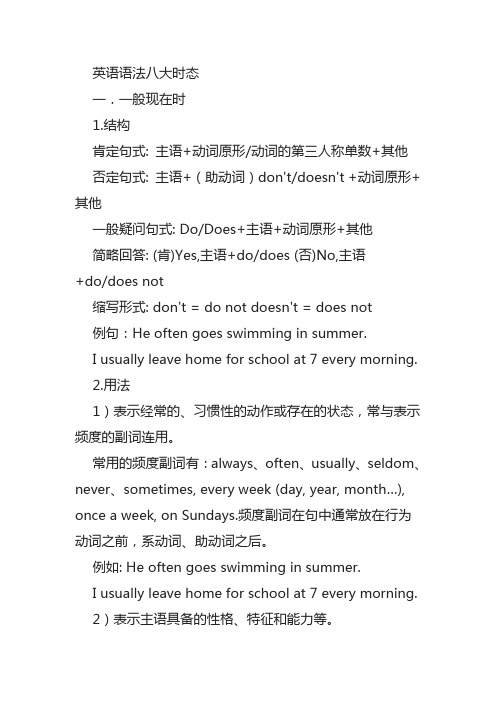
英语语法八大时态一.一般现在时1.结构肯定句式: 主语+动词原形/动词的第三人称单数+其他否定句式: 主语+(助动词)don't/doesn't +动词原形+其他一般疑问句式: Do/Does+主语+动词原形+其他简略回答: (肯)Yes,主语+do/does (否)No,主语+do/does not缩写形式: don't = do not doesn't = does not例句:He often goes swimming in summer.I usually leave home for school at 7 every morning.2.用法1)表示经常的、习惯性的动作或存在的状态,常与表示频度的副词连用。
常用的频度副词有:always、often、usually、seldom、never、sometimes, every week (day, year, month…), once a week, on Sundays.频度副词在句中通常放在行为动词之前,系动词、助动词之后。
例如: He often goes swimming in summer.I usually leave home for school at 7 every morning.2)表示主语具备的性格、特征和能力等。
例如:All my family love football .My sister is always ready to help others .Ann writes good English but does not speak well.3)表示客观真理、客观存在、自然现象。
例如:The earth moves around the sun.Shanghai lies in the east of China.4)表示按计划或安排好的,或将要发生的动作,可用一般现在时表将来。
初中英语的八大时态结构

初中英语的八大时态结构英语中八种基本时态有:一般现在时、一般过去时、现在进行时、过去进行时、现在完成时、过去完成时、—般将来时、过去将来时。
一、一般现在时基本结构:1)动词+原形(如主语为第三人称单数,谓语动词上要加s,es,或变y为i,再加es)2)如果含有be动词:主语+is/am/are+形容词/名词/介词短语等(主语为第三人称单数用is,主语为I用am,主语为复数用are)例句:Our teachers always arrive early.I am an English teacher.二、一般过去时基本结构:1)主语+动词过去式2)如果含有be动词:主语+was/were+形容词/名词/介词短语等(主语为单数用was,主语为复数用are)例句:She sang a song in class yesterday.They were here just now.三、现在进行时基本结构:am/is/are+doing(主语为I用am,主语为第三人称单数用is,主语为复数用are)例句:It's getting colder and colder.They are doing well in their lessons.四、过去进行时基本结构:was/were + doing例句:She was working at nine o'clock yesterday?When I arrived, they were reading a story.五、现在完成时基本结构:has/have + done(过去分词)(主语为单数用has,主语为复数用have)例句:It has rained recently.They have lived here for more than twenty years.六、过去完成时基本结构:had + done(过去分词)例句:By the end of last week,they had reviewed four books.He had bought the car before 2003.七、一般将来时基本结构:1)is/am/are + going to + do(主语为第三人称单数用is,主语为I用am,主语为复数用are)2) shall/will + do(主语为第一人称可用shall/will,其他人称用will)例句:We are going to visit the factory tomorrow.I think she will be back next week.八、过去将来时基本结构:1)was/were + going to + do(主语为单数用was,主语为复数用were)2)would + do例句:They told me they would go to Beijing.The doctor asked who was going there.。
英语八大时态

一、一般现在时:1、表示:(1)经常做的事(2)习惯性动作(反复发生的动作)(3)客观事实和不变的真理(4)目前存在的状态(5)主语现在的性格、特征、能力2、基本结构: 肯定句:(1)主语 (I,We, You, They) + 动词原形 + ...(2)主语 (He,She,It) + 动词第三人称单数 + ...(3)主语 + be(am,is, are) + ...否定句:(1)主语(I,We, You, They)+ don’t + 动词原形 + ...(2)主语 (He,She,It) + doesn’t + 动词第三人称单数 + ...(3)主语 + be(am,is, are) + not + ...疑问句:(1)Do + 主语 (I,We, You, They) + 动词原形 + ...(2)Does + 主语 (He,She,It) + 动词第三人称单数+ ...(3)be(am,is, are) +主语 + ...3、时间状语:always总是,usually通常,often经常,sometimes有时,seldom很少,hardly几乎不,scarcely几乎不,every day每天,once a week每周一次,yearly每年,monthly每月,等时间状语或频率副词连用。
4、常和一般现在时连用的固定表达法:I promise...我允诺...,I apologize...我道歉...,I advise...我建议...,I insist...我强调...,I agree...我同意...,I refuse...我拒绝...,I suggest...我建议...如:I promise that I won’t be late again. 我答应不再迟到。
I suggest he set off at once. 我建议他应马上出发。
二、现在进行时:1、表示:(1)说话时正在进行的事情和动作.(2)现阶段正在进行的事情和动作.2、基本结构: 主语 + am, is, are + 动词ing + ...3、时间状语: now, at this time, these days, look, listen三、一般过去时:1、表示:(1)过去某时发生的事情和动作(2)过去习惯性动作或行为(3)过去经常性的动作或行为(句末常有表示过去的时间短语)2、基本结构:(1)主语 + 动词过去式 +...(2)主语 + was/were + ...3、时间状语:…ago, yesterday, the day before yesterday, last week(year,night, month…), in 1989, just now, at the age of 5, oneday, at last, at first, finally四、现在完成时;1、表示:(1)过去发生已经完成的动作,对现在赞成的影响或结果。
高中英语八大时态
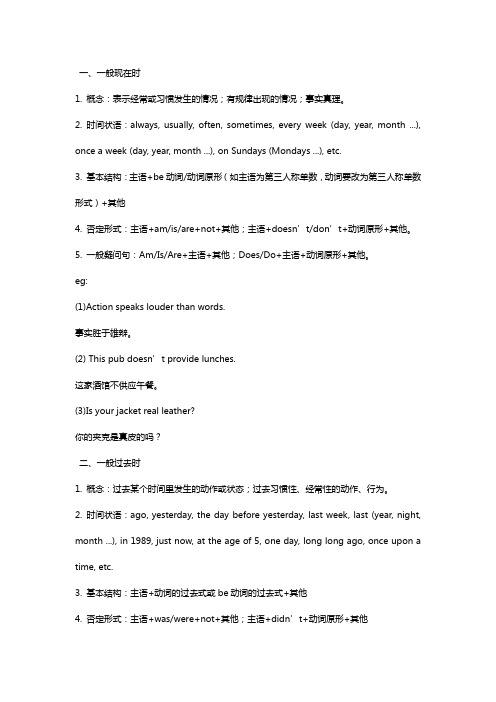
一、一般现在时1. 概念:表示经常或习惯发生的情况;有规律出现的情况;事实真理。
2. 时间状语:always, usually, often, sometimes, every week (day, year, month ...), once a week (day, year, month ...), on Sundays (Mondays ...), etc.3. 基本结构:主语+be动词/动词原形(如主语为第三人称单数,动词要改为第三人称单数形式)+其他4. 否定形式:主语+am/is/are+not+其他;主语+doesn’t/don’t+动词原形+其他。
5. 一般疑问句:Am/Is/Are+主语+其他;Does/Do+主语+动词原形+其他。
eg:(1)Action speaks louder than words.事实胜于雄辩。
(2) This pub doesn’t provide lunches.这家酒馆不供应午餐。
(3)Is your jacket real leather?你的夹克是真皮的吗?二、一般过去时1. 概念:过去某个时间里发生的动作或状态;过去习惯性、经常性的动作、行为。
2. 时间状语:ago, yesterday, the day before yesterday, last week, last (year, night, month ...), in 1989, just now, at the age of 5, one day, long long ago, once upon a time, etc.3. 基本结构:主语+动词的过去式或be动词的过去式+其他4. 否定形式:主语+was/were+not+其他;主语+didn’t+动词原形+其他5. 一般疑问句:Was/were+主语+其他;Did+主语+动词原形+其他eg:(1)She often came to help us in those days.那些天她经常来帮助我们。
英语八大时态总结表
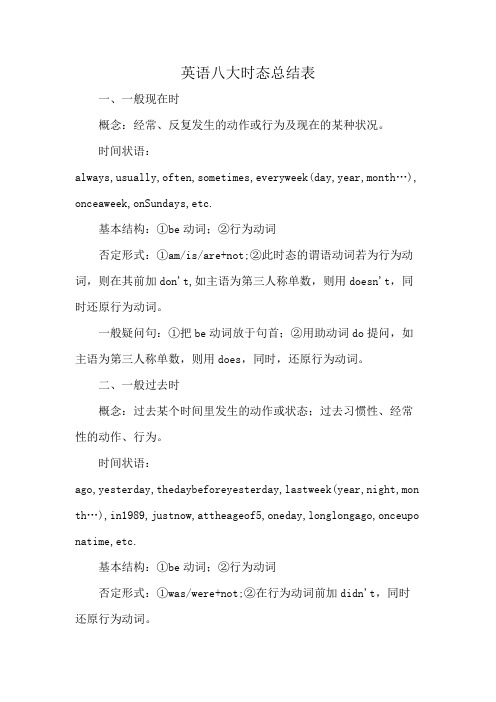
英语八大时态总结表一、一般现在时概念:经常、反复发生的动作或行为及现在的某种状况。
时间状语:always,usually,often,sometimes,everyweek(day,year,month…), onceaweek,onSundays,etc.基本结构:①be动词;②行为动词否定形式:①am/is/are+not;②此时态的谓语动词若为行为动词,则在其前加don't,如主语为第三人称单数,则用doesn't,同时还原行为动词。
一般疑问句:①把be动词放于句首;②用助动词do提问,如主语为第三人称单数,则用does,同时,还原行为动词。
二、一般过去时概念:过去某个时间里发生的动作或状态;过去习惯性、经常性的动作、行为。
时间状语:ago,yesterday,thedaybeforeyesterday,lastweek(year,night,mon th…),in1989,justnow,attheageof5,oneday,longlongago,onceupo natime,etc.基本结构:①be动词;②行为动词否定形式:①was/were+not;②在行为动词前加didn't,同时还原行为动词。
一般疑问句:①was或were放于句首;②用助动词do的过去式did提问,同时还原行为动词。
三、现在进行时概念:表示现阶段或说话时正在进行的动作及行为。
时间状语:now,atthistime,thesedays,etc.基本结构:am/is/are+doing否定形式:am/is/are+not+doing.一般疑问句:把be动词放于句首。
四、过去进行时概念:表示过去某段时间或某一时刻正在发生或进行的行为或动作。
时间状语:atthistimeyesterday,atthattime或以when引导的谓语动词是一般过去时的时间状语等。
基本结构:was/were+doing否定形式:was/were+not+doing.一般疑问句:把was或were放于句首。
- 1、下载文档前请自行甄别文档内容的完整性,平台不提供额外的编辑、内容补充、找答案等附加服务。
- 2、"仅部分预览"的文档,不可在线预览部分如存在完整性等问题,可反馈申请退款(可完整预览的文档不适用该条件!)。
- 3、如文档侵犯您的权益,请联系客服反馈,我们会尽快为您处理(人工客服工作时间:9:00-18:30)。
初中英语动词时态归纳总结对照表初中英语时态专项练习1、一般现在时。
通常用“usually, often, every day, sometimes”。
一般现在时基本用法介绍一、一般现在时的功能1.表示事物或人物的特征、状态。
如:The sky is blue.天空是蓝色的。
2.表示经常性或习惯性的动作。
如:I get up at six every day.我每天六点起床。
3.表示客观现实。
如:The earth goes around the sun.地球绕着太阳转。
二、一般现在时的构成:肯定句:1).主语+系动词 be(is, am, are )+名词(形容词,介词短语)2) .其他主语+动词原形+其它第三人称单数+动词-s+其它如:I am a boy.我是一个男孩。
We study English.我们学习英语。
Mary likes Chinese.玛丽喜欢汉语。
三、一般现在时的变化否定句:1)主语+ be (is,am,are)+ not +其它。
如:He is not a worker.他不是工人。
2)其他主语+do not(don’t)动词原形+其它I don't like bread第三人称单数+does not(doesn’t)动词原形+其它He doesn't often play.一般疑问句:1)Be(Is,Are) +主语+其它?如:-Are you a student? -Yes. I am. / No, I'm not.2)Do其他主语+动词原形+其它?Does+第三人称单数+动词原形+其它+?注意:遇I/we—you, my—your, some—any.Does she go to work by bike? - Yes, she does. / No, she doesn't.Do you often play football?- Yes, I do. / No, I don't.特殊疑问句:疑问词+一般疑问句。
如:Where is my bike?How does your father go to work?一般现在时用法专练:一、用括号动词的适当形式填空。
1. He often ________(have) dinner at home.2. Daniel and Tommy _______(be) in Class One.3. We _______(not watch) TV on Monday.4. Nick _______(not go) to the zoo on Sunday.5. ______ they ________(like) the World Cup?二、按照要求改写句子1. Daniel watches TV every evening.(改为否定句)2. I do my homework every day.(改为一般疑问句,作否定回答)3. She likes milk.(改为一般疑问句,作肯定回答)7. I like taking photos in the park.(对划线部分提问)8. John comes from Canada.(对划线部分提问)三、改错(划出错误的地方,将正确的写在横线上)1. Is your brother speak English? __________________2. Does he likes going fishing? __________________3. He likes play games after class. __________________4. Mr. Wu teachs us English. __________________5. She don’t do her homework on Sundays. _________________2、现在进行时。
通常用“now/look/listen”.1.现在进行时表示现在正在进行或发生的动作,也可表示当前一段时间的活动或现阶段正在进行的动作。
2.现在进行时的结构:.肯定句:主语+be(is,am,are ) +动词现在分词-ingeg: I am(not) doing my homework.You/We/They are(not) reading.He/She/It is(not) eating.否定句:主语+be(is,am,are )+not + 动词现在分词-ing一般疑问句:Is(Are)+主语+动词现在分词-ing?特殊疑问:疑问词+ be + 主语 + 动词ing?3.动词加ing的变化规则1)一般情况下,直接加ing,如:cook-cooking2)以不发音的e结尾,去e加ing,如:make-making, taste-tasting3)如果末尾是一个元音字母和一个辅音字母,双写末尾的辅音字母,再加ing,如:run-running, stop-stopping,swim—swimming4. 现在进行时专项练习:一、写出下列动词的现在分词:play________ run__________ swim _________make__________ go_________ like________ write________ _ski___________ read________ have_________ sing ________ dance_________ put_________ see________ buy _________ love____________ live_______二、用所给的动词的正确形式填空:1.The boy __________________ ( draw)a picture now.2. Listen .Some girls _______________ ( sing)in the classroom .3. My mother _________________ ( cook )some nice food now.4. What _____ you ______ ( do ) now?5. Look . They _______________( have) an English lesson .10.______Helen____________(wash )clothes? Yes ,she is .三、句型转换:1. They are doing housework .(分别改成一般疑问句和否定句)2.The students are cleaning the classroom . ( 改一般疑问句并作肯定和否定回答)3.I’m playing the football in the playground .(对划线部分进行提问)3、一般过去时态一般过去时通常用“a moment ago, just now, yesterday, last…”等。
1.一般过去时表示过去某个时间发生的动作或存在的状态,常和表示过去的时间状语连用。
一般过去时也表示过去经常或反复发生的动作感。
2.Be动词在一般过去时中的变化:⑴am 和is在一般过去时中变为was。
(was not=wasn’t)⑵are在一般过去时中变为were。
(were not=weren’t)⑶带有was或were的句子,其否定、疑问的变化和is, am, are一样,即否定句在was或were 后加not,一般疑问句把was或were调到句首。
3.行为动词的一般过去时变化4.动词过去式的变化:规则动词的变化:不规则动词的变化:原形过去式原形过去式原形过去式原形过去式sweep swept teach taught have had go wentkeep kept think thought do did find foundsleep slept buy bought eat ate say saidfeel felt drink drank is/am was take tookread read give gave are were mean meantput put sing sang drive drove meet metcut cut begin began speak spoke make madelet let ring rang write wrote see sawfly flew run ran ride rode come camedraw drew sit sat hear heard tell told grow grew learn learned/ learnt get got know knew5.特殊疑问句:⑴疑问词+did+主语+动词原形?如: What did Jim do yesterday?⑵疑问词当主语时:疑问词+动词过去式?如:Who went to home yesterday?过去时练习:写出下列动词的过去式 is\am_________ fly_______ plant________ are ________drink_________ play_______ go________ make ________ does_________ dance________ worry________ ask _____ taste_________ eat__________ draw________ put ______ throw________ kick_________ pass_______ do ________Be动词的过去时练习:A一、用be动词的适当形式填空1. I _______ at school just now.2. He ________ at the camp last week.3. We ________ students two years ago.4. They ________ on the farm a moment ago.5. Yang Ling ________ eleven years old last year.二、句型转换1. It was exciting.否定句:________________________________________________一般疑问句:____________________________________________肯、否定回答:__________________________________________2. All the students were very excited.否定句:________________________________________________一般疑问句:____________________________________________肯、否定回答:__________________________________________行为动词的过去时练习:B一、用行为动词的适当形式填空1. He _________ (live) in Wuxi two years ago.2. The cat ________ (eat) a bird last night.3. We _______ (have) a party last Halloween.4. Nancy ________ (pick) up oranges on the farm last week.5. I ________ (make) a model ship with Mike yesterday.二、句型转换1. Su Hai took some photos at the Sports day.否定句:________________________________________________一般疑问句:____________________________________________肯、否定回答:__________________________________________2. We sang some English songs.否定句:________________________________________________一般疑问句:____________________________________________肯、否定回答:__________________________________________三、中译英1.格林先生去年住在中国。
